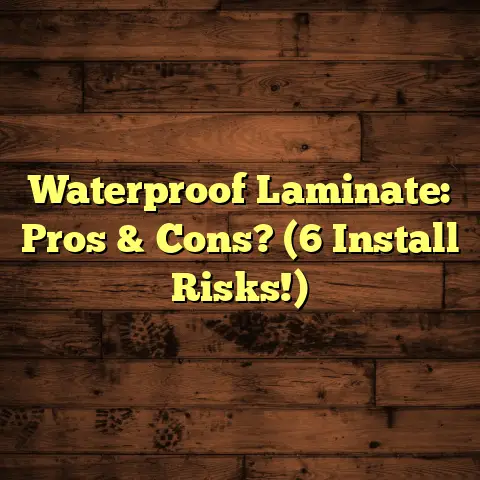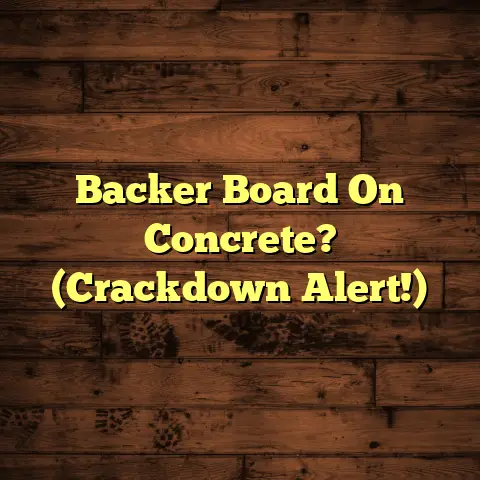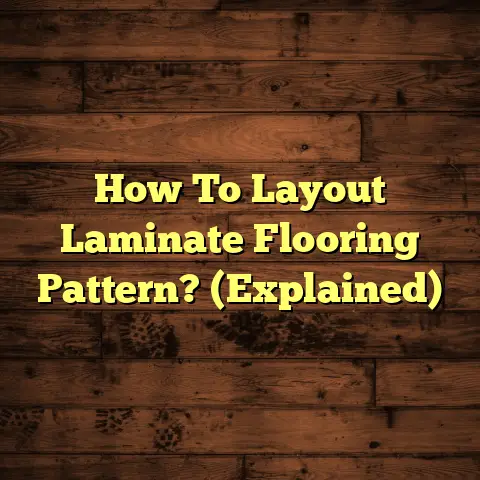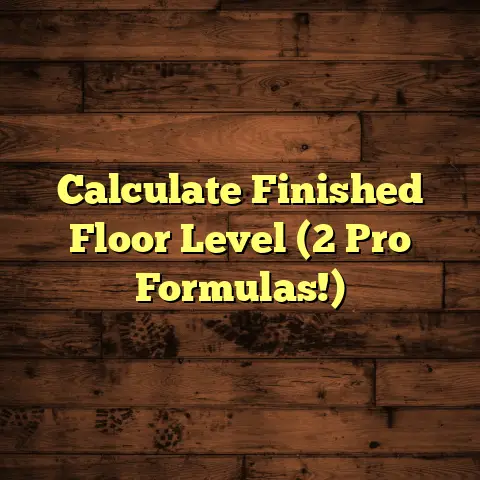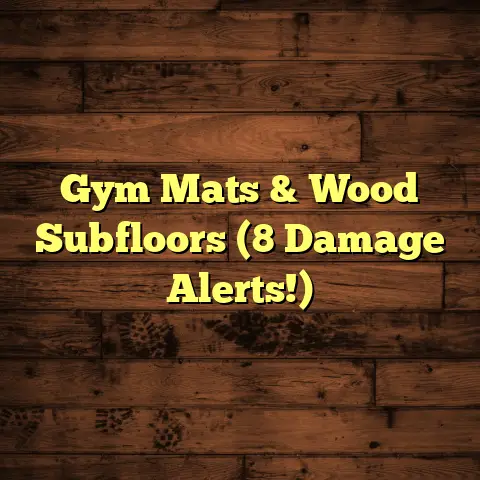Flooring for 500 Sq Ft? (How Much? – 1 Calc!)
Imagine stepping into your newly renovated space.
A place that truly feels like you.
The flooring beneath your feet?
It’s more than just a surface.
It’s the foundation of your home’s comfort and style.
Whether it’s the warmth of hardwood, the sleekness of tile, or the plushness of carpet, your flooring choice sets the tone.
But let’s be real, a big question always pops up:
“How much is this really going to cost?”
I get it.
That’s why I’m here to help you navigate the world of flooring options for a 500 sq ft space.
We’ll break down the costs, from materials to installation, so you can make smart decisions that fit your vision and your budget.
Let’s get started!
1. Understanding Your Space (500 sq ft)
So, what does 500 sq ft actually look like?
Think of a decent-sized studio apartment, a cozy one-bedroom, or a small office.
It’s a manageable space, but the right flooring can make it feel much larger and more functional.
Space planning is key.
Dark floors can make a room feel smaller, while lighter colors open it up.
Directional patterns, like planks laid lengthwise, can visually lengthen a room.
I’ve seen it countless times – the right flooring transforms a cramped space into an inviting haven.
2. Types of Flooring Options
Let’s dive into the different types of flooring.
I’ll give you the lowdown on each, including their pros, cons, and approximate costs.
Hardwood Flooring
Ah, hardwood.
Classic, timeless, and adds real value to your home.
Think oak, maple, cherry – each with its own unique grain and color.
- Oak: A popular choice, known for its durability and versatility. Expect to pay around $8-$15 per square foot installed.
- Maple: Lighter in color and has a smoother grain. Costs are similar to oak.
- Cherry: Rich, reddish tones that add warmth. Can be a bit pricier, around $10-$18 per square foot installed.
Benefits:
- Adds value to your home.
- Beautiful and timeless look.
- Durable (if properly maintained).
Drawbacks:
- Can be expensive.
- Susceptible to scratches and water damage.
- Requires regular maintenance.
Laminate Flooring
Laminate is a fantastic cost-effective alternative to hardwood.
It’s basically a high-resolution photo of wood grain glued to a composite core.
Don’t let that fool you, though!
Some high-end laminates look incredibly realistic.
Expect to pay around $3-$7 per square foot installed.
Benefits:
- Much more affordable than hardwood.
- Easy to install (great for DIY projects).
- Durable and scratch-resistant.
Drawbacks:
- Doesn’t add as much value to your home as hardwood.
- Can sound a bit hollow underfoot.
- Not as water-resistant as vinyl.
Vinyl Flooring
Vinyl has come a long way!
Forget the cheap, flimsy vinyl of the past.
Today’s vinyl flooring is stylish, durable, and waterproof.
You’ve got a few options here:
- Sheet Vinyl: Large rolls that cover the entire floor. Very water-resistant and affordable (around $2-$5 per square foot installed).
- Vinyl Tile: Individual tiles that can be arranged in various patterns. Offers more design flexibility (around $3-$8 per square foot installed).
- Luxury Vinyl Plank (LVP): Designed to mimic the look of hardwood. Very durable and waterproof (around $4-$10 per square foot installed).
Benefits:
- Waterproof (perfect for bathrooms and kitchens).
- Durable and easy to clean.
- Available in a wide range of styles and colors.
Drawbacks:
- Can feel a bit cold underfoot.
- May not add as much value to your home as hardwood or tile.
Tile Flooring
Tile is a classic choice for kitchens, bathrooms, and entryways.
It’s durable, water-resistant, and comes in endless styles.
Here’s a quick breakdown:
- Ceramic Tile: A popular and affordable choice. Easy to clean and comes in a wide range of colors and patterns (around $5-$10 per square foot installed).
- Porcelain Tile: More durable and water-resistant than ceramic. Often used in high-traffic areas (around $7-$15 per square foot installed).
- Natural Stone Tile: Adds a touch of luxury and sophistication. Options include granite, marble, and slate (around $10-$30+ per square foot installed).
Benefits:
- Extremely durable and long-lasting.
- Water-resistant and easy to clean.
- Adds value to your home (especially natural stone).
Drawbacks:
- Can be expensive (especially natural stone).
- Cold underfoot.
- Can be slippery when wet.
Carpet Flooring
Carpet is all about comfort and warmth.
It’s a great choice for bedrooms, living rooms, and playrooms.
Here’s a look at the different types of carpet fibers:
- Nylon: Durable and stain-resistant. A popular choice for high-traffic areas (around $3-$7 per square foot installed).
- Polyester: Softer than nylon but not as durable. A good option for bedrooms (around $2-$5 per square foot installed).
- Wool: Natural, luxurious, and incredibly soft. Also very expensive (around $8-$20+ per square foot installed).
Benefits:
- Soft and comfortable underfoot.
- Provides insulation and reduces noise.
- Available in a wide range of colors and styles.
Drawbacks:
- Can be difficult to clean.
- Susceptible to stains and allergens.
- May not be the best choice for high-moisture areas.
3. Cost Breakdown: Materials and Installation
Okay, let’s get down to the nitty-gritty: the costs.
I’m going to give you some average costs per square foot, but remember that these can vary depending on your location, the specific materials you choose, and the contractor you hire.
| Flooring Type | Average Cost Per Sq Ft (Materials Only) | Average Installation Cost Per Sq Ft |
|---|---|---|
| Hardwood | $5 – $12 | $3 – $6 |
| Laminate | $2 – $5 | $1 – $3 |
| Vinyl (Sheet) | $1 – $3 | $1 – $2 |
| Vinyl (Tile/LVP) | $2 – $8 | $2 – $4 |
| Tile (Ceramic) | $3 – $7 | $2 – $5 |
| Tile (Porcelain) | $5 – $12 | $3 – $6 |
| Carpet | $2 – $6 | $1 – $3 |
Additional Costs:
Don’t forget to factor in these extra expenses:
- Underlayment: Provides cushioning and sound insulation (around $0.50 – $2 per square foot).
- Adhesives: Needed for certain types of flooring (around $0.25 – $0.50 per square foot).
- Finishing: Includes things like baseboards, trim, and sealant (can vary widely depending on your choices).
- Subfloor Preparation: If your subfloor is uneven or damaged, you’ll need to repair it before installing new flooring.
DIY vs. Hiring Professionals:
DIY installation can save you money, but it’s not for everyone.
If you’re comfortable with basic home improvement tasks, you can tackle laminate, vinyl, or even some types of tile.
But for hardwood or complex tile installations, I always recommend hiring a professional.
Trust me, it’s worth the investment to ensure a flawless finish.
4. Calculating the Total Cost for 500 sq ft
Alright, let’s put it all together and calculate the total cost for your 500 sq ft space.
Here’s a step-by-step guide:
- Choose Your Flooring Type: Select the material that best fits your needs and budget.
- Determine the Material Cost: Multiply the cost per square foot by 500 (your total square footage).
- Factor in Additional Costs: Add the cost of underlayment, adhesives, and finishing.
- Estimate Installation Costs: If you’re hiring a professional, get quotes from several contractors. If you’re doing it yourself, factor in the cost of tools and supplies.
- Add It All Up: Combine the material costs, additional costs, and installation costs to get your total estimate.
Example Scenarios:
Let’s run through a few scenarios to illustrate how the costs can vary:
-
Scenario 1: Budget-Friendly Laminate
- Laminate flooring: $3 per sq ft
- Underlayment: $0.50 per sq ft
- Installation (DIY): $0
- Total Material Cost: (3+0.50)x 500 = $1,750
-
Scenario 2: Mid-Range Luxury Vinyl Plank (LVP)
- LVP flooring: $6 per sq ft
- Underlayment: $1 per sq ft
- Professional Installation: $3 per sq ft
- Total Cost: (6+1+3)x 500= $5,000
-
Scenario 3: High-End Hardwood
- Hardwood flooring: $10 per sq ft
- Underlayment: $1 per sq ft
- Professional Installation: $5 per sq ft
- Total Cost: (10+1+5)x 500= $8,000
Getting Quotes and Estimates:
I can’t stress this enough: get multiple quotes from contractors!
This is the best way to ensure you’re getting a fair price.
Be sure to ask for a detailed breakdown of the costs, including materials, labor, and any additional fees.
5. Long-Term Considerations
Choosing flooring isn’t just about the initial cost.
You also need to think about the long term.
- Longevity: Some flooring types, like hardwood and tile, can last for decades with proper care. Others, like carpet and laminate, may need to be replaced sooner.
- Maintenance: Hardwood requires regular sanding and refinishing, while carpet needs professional cleaning. Vinyl and tile are generally low-maintenance.
- Resale Value: Hardwood and natural stone tile can increase the value of your home, while cheaper options like laminate may not have as much of an impact.
6. Final Thoughts
Choosing the right flooring for your 500 sq ft space is a big decision.
It’s an investment in your home, your comfort, and your style.
I hope this article has given you the knowledge and confidence you need to make informed choices.
Remember to visualize your dream space, consider your budget, and don’t be afraid to ask for help.
Now go out there and create a space you’ll love for years to come!
